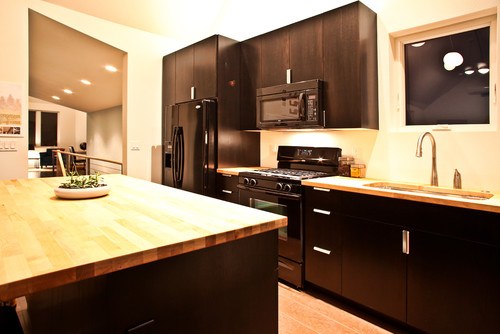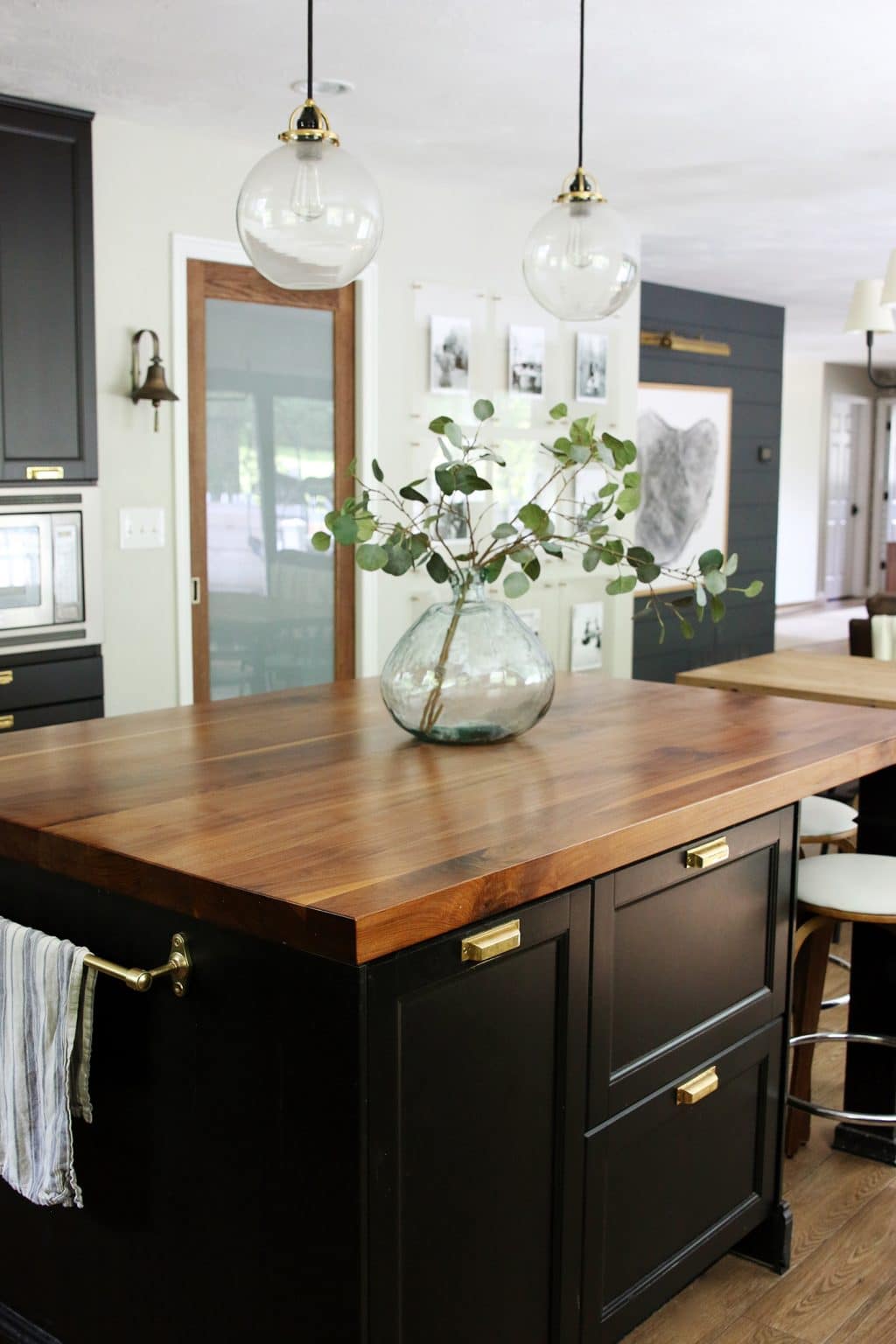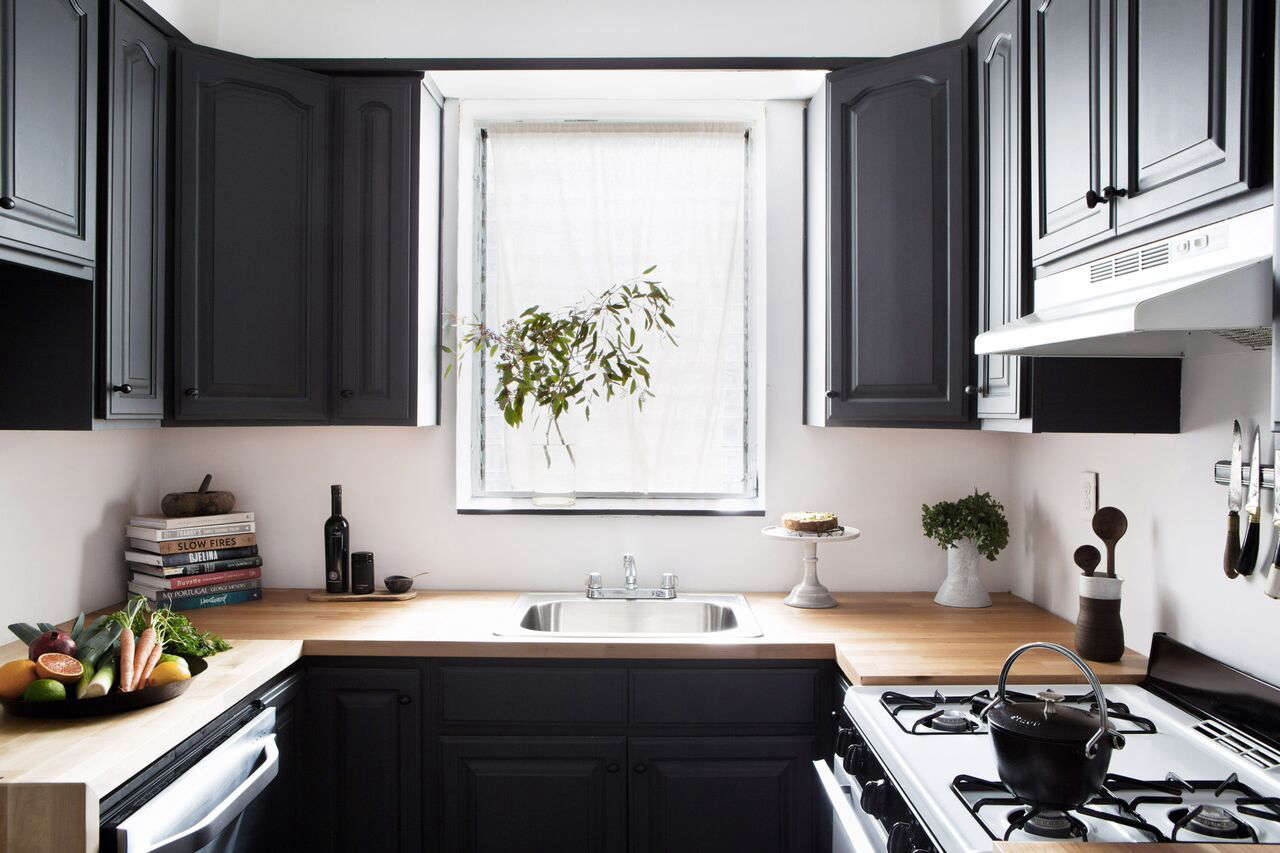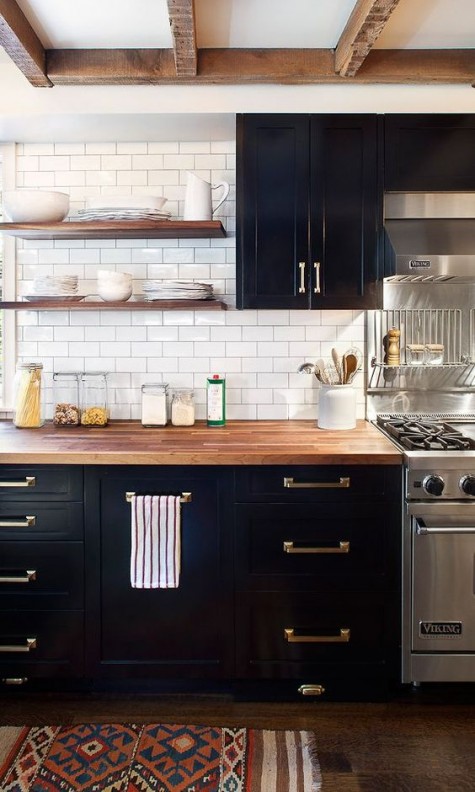Butcher block countertops paired with dark cabinets create a warm and inviting aesthetic in kitchens, blending the natural beauty of wood with the sophistication of dark finishes. This combination is increasingly popular in contemporary and traditional kitchen designs, offering a versatile and functional workspace that can suit various styles. Butcher block countertops are typically made from hardwoods like maple, walnut, or oak, which are known for their durability and attractive grain patterns. These countertops can add a touch of rustic charm or modern elegance, depending on the choice of wood and finish.
One of the primary benefits of butcher block countertops is their natural warmth and beauty. The rich grain patterns and unique color variations of the wood bring an organic element into the kitchen, contrasting nicely with the sleekness of dark cabinets. This pairing can soften the overall look of the kitchen, making it feel more welcoming and comfortable. The tactile quality of wood also adds a layer of sensory appeal that stone or synthetic materials often lack.
Butcher block countertops are not only aesthetically pleasing but also highly functional. They provide a durable and practical surface for food preparation, particularly for tasks like chopping and cutting. The wood’s natural resilience helps protect knives, reducing dulling compared to harder surfaces like granite or quartz. Additionally, wood has natural antibacterial properties, which can make butcher block countertops a hygienic choice for kitchen use. However, proper care and maintenance are crucial to ensure their longevity and sanitary condition.
The maintenance of butcher block countertops involves regular oiling to keep the wood hydrated and prevent it from drying out or cracking. Food-grade mineral oil is typically recommended, as it is safe for food contact and helps to enhance the wood’s natural color. Depending on the wood species and usage, oiling may be needed monthly or as soon as the wood appears dry. In addition to oiling, cleaning with mild soap and water is sufficient for everyday maintenance. For tougher stains, a mixture of lemon juice and salt can be used as a gentle abrasive cleaner.

When combined with dark cabinets, butcher block countertops can create a striking visual contrast that enhances the overall design of the kitchen. The dark cabinets, which may be painted or stained in shades like black, navy, or deep espresso, provide a bold backdrop that highlights the lighter, natural tones of the wood. This contrast can add depth and dimension to the space, making the countertops stand out as a feature element. Moreover, dark cabinets can help ground the design, giving it a modern, sophisticated edge.
Choosing the right type of wood for butcher block countertops is an important decision that can impact the kitchen’s aesthetic and functionality. Maple and oak are popular choices due to their durability and availability. Maple offers a light, uniform grain, making it ideal for a clean, contemporary look, while oak has a more pronounced grain pattern that can add character and warmth. Walnut, on the other hand, provides a rich, dark hue that can complement darker cabinets and add a luxurious touch to the kitchen.
The finish applied to butcher block countertops can also influence their appearance and performance. A natural oil finish enhances the wood’s grain and provides a warm, matte look, while a varnish or polyurethane finish offers a more glossy appearance and added protection against stains and moisture. However, it is important to note that a varnish finish can make the surface harder and more prone to showing scratches. Homeowners should consider their usage and aesthetic preferences when choosing the finish for their butcher block countertops.

The combination of butcher block countertops and dark cabinets is versatile and can be adapted to various kitchen styles. In a rustic or farmhouse-style kitchen, the natural, unfinished look of butcher block countertops can complement distressed or painted dark cabinets, creating a cozy and lived-in feel. For a more contemporary or industrial look, sleek, dark cabinets paired with a smooth, polished butcher block countertop can provide a striking contrast and a clean, modern aesthetic.
Lighting is a crucial factor in kitchens with dark cabinets and butcher block countertops. Adequate lighting ensures that the space does not feel too dark or heavy, highlighting the natural beauty of the wood and the richness of the cabinets. Under-cabinet lighting can be particularly effective, illuminating the countertops and enhancing the wood’s texture and color. Additionally, pendant lights or chandeliers can add a decorative element while providing task lighting for food preparation areas.
In terms of layout and design, butcher block countertops can be used in various ways to complement dark cabinets. They can serve as the primary countertop material, providing a continuous surface throughout the kitchen, or they can be used as an accent, such as on an island or a designated prep area. The latter approach allows homeowners to incorporate multiple countertop materials, such as stone or stainless steel, for a mixed-material look that adds visual interest and functionality.

Sustainability is another consideration when choosing butcher block countertops. Many hardwoods used in butcher block are sourced from responsibly managed forests, making them an eco-friendly option. Additionally, wood is a renewable resource, and at the end of its life cycle, butcher block countertops can be sanded down and refinished or even repurposed for other uses, reducing waste. This sustainability aspect makes them appealing to environmentally conscious homeowners.
The pairing of butcher block countertops and dark cabinets also offers practical benefits in terms of versatility and resale value. This combination appeals to a wide range of tastes and preferences, making it a safe choice for those considering selling their home in the future. The timeless appeal of natural wood and the classic elegance of dark cabinetry are unlikely to go out of style, ensuring that the kitchen remains attractive to potential buyers.
Butcher block countertops paired with dark cabinets create a harmonious blend of natural beauty and modern sophistication. The warm, organic feel of the wood complements the bold, sleek look of dark cabinets, making this combination suitable for various design styles. The functional benefits, including durability and ease of maintenance, add to the appeal of butcher block countertops, while the versatility and potential for customization make them a valuable addition to any kitchen.

Common Mistakes to Avoid
Inadequate Maintenance: One of the most common mistakes with butcher block countertops is neglecting regular maintenance, such as oiling. Failure to oil the wood can lead to dryness, cracking, and damage. It’s crucial to follow a consistent maintenance routine to preserve the countertop’s appearance and durability.
Choosing the Wrong Wood Species: Different wood species have varying levels of hardness and durability. Choosing a softer wood for a high-traffic kitchen can result in dents and scratches. It’s important to select a wood species that matches the kitchen’s usage needs and aesthetic preferences.
Improper Finishing: Applying the wrong type of finish or insufficient layers can compromise the wood’s protection against stains and moisture. It’s essential to choose a finish that suits the intended use of the countertop and to apply it correctly.
Inconsistent Design Choices: Pairing butcher block countertops with dark cabinets requires careful consideration of color and texture. Choosing mismatched tones or styles can create a disjointed look. It’s important to consider the overall design scheme and ensure that all elements work together harmoniously.
Ignoring Lighting Needs: Dark cabinets can make a kitchen feel dim if not properly lit. Inadequate lighting can detract from the beauty of the butcher block countertops and make the space feel smaller. Proper lighting, including under-cabinet lighting, is essential to showcase the materials and enhance the kitchen’s ambiance.
Overlooking Edge Treatment: The edge profile of butcher block countertops can affect both aesthetics and functionality. Sharp edges can be prone to chipping, while rounded edges can provide a softer look. Choosing the right edge treatment is important for both safety and design consistency.

How do I maintain and care for butcher block countertops?
Maintaining butcher block countertops involves regular cleaning and oiling. Clean the surface with mild soap and water, avoiding harsh chemicals that can damage the wood. To keep the wood hydrated and prevent cracking, apply food-grade mineral oil regularly, typically once a month or as needed. For deeper cleaning or to remove stains, a mixture of lemon juice and salt can be used. Sanding the surface lightly can help remove any scratches or dents, followed by re-oiling. Proper maintenance not only preserves the countertop’s appearance but also ensures its longevity and hygiene.
Are butcher block countertops sanitary for food preparation?
Butcher block countertops can be a sanitary surface for food preparation if properly maintained. The wood’s natural antibacterial properties can help reduce the risk of bacterial growth. However, it’s important to clean the surface thoroughly after preparing raw meat and other potentially contaminating foods. Using a mixture of vinegar and water can help disinfect the surface. Regular oiling helps create a barrier against moisture and food particles, enhancing the countertop’s sanitary properties. Additionally, using separate cutting boards for different types of food can further ensure hygiene.
How do butcher block countertops compare to other materials in terms of durability?
Butcher block countertops are durable but do require more maintenance than some other materials like quartz or granite. Wood is softer than stone, making it more susceptible to scratches and dents. However, these imperfections can often be sanded out, and the surface can be refinished, extending the countertop’s lifespan. The choice of wood species also affects durability; hardwoods like maple and oak are more resistant to wear and tear than softer woods. With proper care, including regular oiling and cleaning, butcher block countertops can last for many years.

What wood species are best for butcher block countertops?
The choice of wood species for butcher block countertops depends on the desired aesthetic and functional characteristics. Maple is a popular choice due to its hardness, durability, and light color, which can brighten a space. Oak is another durable option, known for its distinctive grain patterns that add character to the countertop. Walnut offers a darker, richer hue that can complement dark cabinets beautifully. Other options include cherry, teak, and bamboo, each offering unique colors and grain patterns. The choice of wood should consider factors like hardness, grain pattern, and color to match the kitchen’s design and usage needs.
Can butcher block countertops be used around sinks and other wet areas?
Butcher block countertops can be used around sinks and other wet areas, but extra care is needed to prevent water damage. Proper sealing and regular maintenance are crucial to protect the wood from moisture. Applying a water-resistant finish, such as a varnish, can provide additional protection. It’s also important to wipe up spills promptly and avoid letting water sit on the surface. Using a separate cutting board for wet tasks can help minimize direct contact with water. With proper care, butcher block countertops can be a practical and attractive choice for wet areas.
Is professional installation necessary for butcher block countertops?
While some skilled DIYers may choose to install butcher block countertops themselves, professional installation is often recommended. Proper installation ensures that the countertop is level, securely fastened, and properly sealed. This is especially important for achieving a seamless look and preventing issues like warping or cracking. Professional installers also have the tools and expertise to make precise cuts and finishes, particularly around sinks and edges. Investing in professional installation can help avoid costly mistakes and ensure the countertops look and perform their best.

A Big Sale on Butcher Block Countertops! (You can use them

The Baltic Butcher Block 96-in x 24.96-in x 1.75-in Unfinished Natural Straight Butcher Block Birch Countertop

Butcher Block Countertops For Your Kitchen

Related articles:
- Can You Paint Butcher Block Countertops
- Butcher Block Countertops With White Cabinets
- Pine Butcher Block Countertops
- Butcher Block Countertops Walnut
- Maple Butcher Block Countertops
- Care Of Butcher Block Countertop
- Butcher Block Countertops Maintenance
- Antique Butcher Block Countertops
- Butcher Block Countertop Sealing
- Wood Butcher Block Countertop